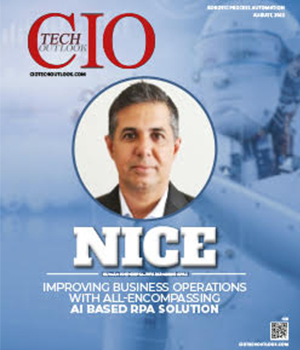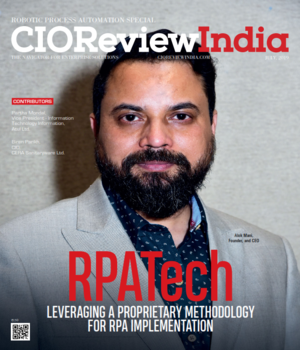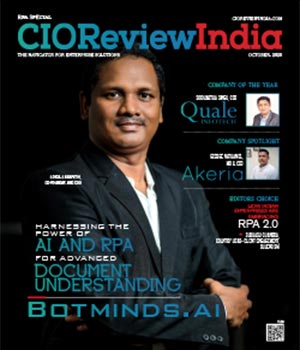
RPA in Pharma Quality
Anniruddha Mehta, Head IT & CIO, Prince Pipes and Fittings Ltd | Tuesday, 12 April 2022, 12:57 IST

Introduction
Traditionally slow in the adoption of technology, the industry is now undergoing rapid changes due to the development of several technologies. The prominent pharma industry trends include artificial intelligence (AI), additive manufacturing, block chain, and other Industry 4.0 technologies.
Pharma can be broadly categorized in 2 IT verticals
- GxP - GxP is an acronym that refers to the regulations and guidelines applicable to life sciences organizations that make food and medical products such as drugs, medical devices, and medical software applications.
- Non – GxP - Non-GxP generally refers to something that isn't compliant or wasn't designed with compliance in mind. For example, a software system that isn't designed for regulated industries would be considered non-GxP.
When it comes to technology the above impacts the complete implementation approach as well as the way an organization deals with the product and the process.
“Can I search for emotions in this speech?” That is where we are heading to, when it comes to technology. The questions still remain the same; How can I increase productivity? How can I improve the numbers? How can I make correct decisions?
It all started with IR 3.0, where the need remained the same, but the solution for the same was the digitization of electronic systems across manufacturing companies.
Today with IR 4.0, the need again is the same, but the solution is different where every organization is talking about the nine pillars of technology
• Autonomous Robots
• Big Data Analytics
• Cloud Computing
• Internet of Things (IoT)
• Additive Manufacturing (3D Printing)
• Interoperability
• Cybersecurity
• Augmented Reality
• Simulation.
Let’s connect the above scenario with Robotic Process Automation.
“A powerful automation solution which can make or break a process, if implemented correctly can achieve increased quality, consistent quality, improved process monitoring and analytics and process scalability”.
Case Study
An Indian Pharmaceutical Company has automated their audit process, which is a unique case study where a non-core work area uses RPA as a solution. A regulatory audit is a non-core area for a pharma company but of major significance for them. Applying machine learning where the auditor would demand for data, based on the documents viewed; is an innovation - a mixture of Attended RPA and Unattended RPA.
The Players
- Automation Anywhere
- UiPath
- Blue Prism
- NICE
- Ant
- Pega
- Context
- Jacada
- WinAutomation
- Works
- And many more…
The above are just names heard of not to promote any of them.
There are many players and in the market and also a lot of developers moving towards building an automated flow from the start.
What matters the most is the following while selecting the player
- Subject Matter Expertise and not just technology expertise
- A logical understanding of compliance requirements
- A partner and not a consultant
It can be a daunting challenge to find a liquid handling automation solution that is flexible enough to meet current and future needs, fulfills regulatory requirements, and is fast and easy to integrate into an existing workflow without much training or downtime.
The Possibilities – Use Cases
Non GxP Processes Areas
- Finance
- Supply Chain
- Marketing
GxP Processes Areas
- R&D
- Regulatory Submissions
- Quality & Manufacturing
Non-GxP processes can be easy to implement and can keep improving with the usage and knowledge.
GxP processes are the ones which need the maximum detailing as they would not only involve compliance but also would be more of IPA (intelligent process automation) than RPA(robotic process automation) where RPA would integrate with Machine Learning and Artificial Intelligence.
The ROI would be measured as follows
- A continuous automated management of risk and compliance
- Process controls over people controls achieved
- Count of employee moved to a higher order job
The Reality - Implemented Use Cases
Commercial
- SFA/SFE
- Accounts Payables
- Contract Management
- CRM
- Report Generations
SAP Integration
- Purchase Life Cycle
- Supply Chain
- Report Generations
These are some use cases which are easy to implement immediate return on investment as all of these the measurements terms are more on the following points
- Number of manual iterative processes automated which would directly save human hours
- A huge quantum of manual process replaced by bots
- Processes where there are options to redeploy resources to higher value functions
GxP Use Cases
R&D and Clinical Development
- Entering varying data sets into statistical databases
- Verifying data quality upon completion of studies
- Monitoring protocol compliance
- Submitting the data to regulators
- Clarifying data anomalies
- Designing data collection methods
Regulatory Submissions
- Dossier Management
Quality & Manufacturing
- Analytical Data Processing and Recording
- Method creation and approval
- Cleaning Validation
- Instrument Calibration
One of the most used GxP use case is CSV which a low hanging fruit and a lot of Pharma Cos can benefit out of it.
The Implementation Approach
- Identify which process to automate and there would be a lure to automate everything.
- A wrong RPA can be disastrous for the complete organization. Wrong in terms of both solution and process selection.
- Budget allocation, as it can drain a lot of budget so the right way is to start small but target Core Processes.
- GxP area within QA is the easiest to target.
- Second priority should be Warehouse processes.
- QC & Production should be the last.
- Begin with manual verification and then validate the process which will provide faster gain and lower implementation times.
- This should be similar to a Six Sigma/ Lean implementation where you have leaders (champions), sponsors and evangelists.
Conclusion
Cut through the hype to a successful implementation and an impactful ROI!
CIO Viewpoint
Robotics Process Automation & Artificial...
By Vineet Aggarwal, Head IT, SRL Diagnostics
By Alejandro Alonso Puig, CTO, Infinium Robotics
By Vineet Bansal, CIO, Greenply Industries
CXO Insights
Optimising Test Instrumentation with Robotic...
By Ankit Jain, IT Head, WIKA India
By Anniruddha Mehta, Head IT & CIO, Prince Pipes and Fittings Ltd
RPA in Action in the Financial Sector









